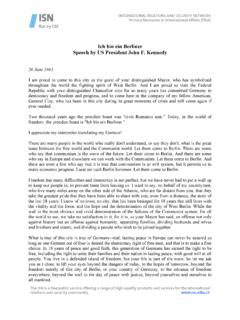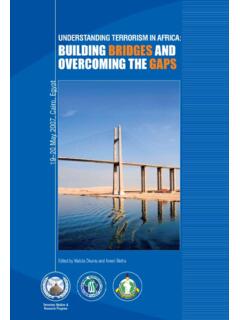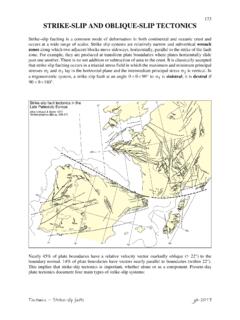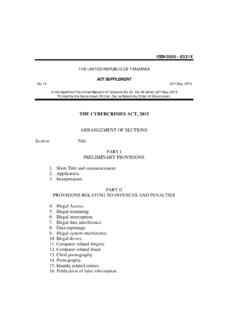Transcription of The Russia-Ukraine Conflict: Cyber and Information …
1 17 October 2014 The Russia-Ukraine Conflict: Cyber andInformation warfare in a Regional ContextWhat lessons can we learn from russia s Cyber and Information campaigns against ukraine ?According to Tim Maurer and Scott Janz, we should expect them to become more integrated,especially in hybrid conflicts , and we need to face facts russia has only revealed the tip of theiceberg when it comes to its Cyber Tim Maurer and Scott Janz for ISNThe violent conflict between russia and ukraine that broke out earlier this year has become a casestudy for hybrid conflict, where traditional kinetic actions are shadowed by Cyber and informationwarfare activity.
2 Now that the Ukrainian and Russian governments have agreed to terms on a peaceplan, it is a good moment to reflect on how this conflict unfolded and what it can teach us about theuse of cyberspace during a conflict that lasted several , it is important to remember that the Russian annexation of Crimea is not the first instance in theregion where traditional military engagement occurred in parallel with Internet based hostile the 2008 russia -Georgia War, for example, botnets were used while kinetic military operationswere taking place to deface websites and to conduct Distributed Denial of Service (DDoS) attacks,which overwhelmed websites and rendered them inaccessible.
3 These actions primarily targetedGeorgian government and news media websites, disrupting communication channels and generatingconfusion at a time of crisis. It is evident that many of these strategies have been redeployed inUkraine, while others have reached new levels of use of cyberspace in the Ukrainian conflict is particularly interesting because it combines bothcyber and Information warfare tactics. This includes tampering with fiber-optic cables and with thecell phones of Ukrainian parliamentarians, as well as more common malicious tools such as DDoSattacks and web defacements. The range of this activity illustrates how Cyber warfare can bedistinguished from Information warfare , and suggests that future kinetic actions are likely to beaccompanied by : The use of cyberspace as the conflict was escalatingThe simmering political tension inside ukraine escalated in November 2013, when former Ukrainianpresident Viktor Yanukovych abandoned plans to sign a trade agreement with the EU.
4 Many believedthis was a sign that he was seeking closer ties with Moscow. Yanukovych s decision incited massprotests that were met with a violent government crackdown. This sudden outbreak of violencedeepened existing fault lines in the country split between those favoring Moscow in the east andthose favoring the European Union in the before Yanukovych s flight in February and the buildup of Russian troops on the Crimean border,pro-Russian separatists began a concerted effort to discredit pro-European Ukrainians. Beginning inlate November, reports emerged that Russian hacker groups were defacing and executing DDoSattacks on websites critical of the Yanukovych government s relationship with russia .
5 This period wascharacterized by low-level hacking targeting highly visible websites, either rendering themunavailable or changing their activity took place as Yanukovych was trying to quell the growing civil unrest against hisgovernment. In addition to the use of police violence , the Yanukovych government also leveraged itscontrol of the national telecommunications infrastructure to intimidate protestors. In late January, forexample, people in the vicinity of clashes between riot police and protestors received an ominous textmessage on their cellphones containing the warning: you are registered as a participant in a massdisturbance. While unsigned, the messages were widely believed to have been sent by theYanukovych government.
6 This activity was part of a mounting Information campaign aimed atcreating or changing the content people were consuming to influence their opinion. This campaignwould intensify as the conflict escalated over the coming months. However, Yanukovych waseventually forced to flee the country and Moscow became more conflict: The use of cyberspace during the hot conflictOn February 28, shortly after Yanukovych had left the country, unmarked soldiers, whom russia sPresident Putin later acknowledged to be Russian troops, seized a military airfield in Sevastopol andthe Simferopol international airport. Concurrently, armed soldiers tampered with fiber optic cables,raiding the facilities of Ukrainian telecom firm Ukrtelecom, which stated afterward that it had lost thetechnical capacity to provide connection between the peninsula and the rest of ukraine and probablyacross the peninsula, too.
7 In addition, cell phones of Ukrainian parliamentarians were hacked and themain Ukrainian government website was shut down for 72 hours after Russian troops entered Crimeaon March 2. Patriotic Ukrainian hacker groups such as Cyber Hundred and Null Sector retaliated withDDoS attacks of their own against websites of the Kremlin and the Central Bank of the jamming of communication channels has been a standard practice of militaries since theadvent of communication technologies, cyberspace has enabled new ways to influence a conflict soutcome. For example, a report released in March by BAE, a British defense and security firm,revealed that dozens of computers in the Ukrainian prime minister s office and several embassiesoutside of ukraine had been infected with malicious software called Snake capable of extractingsensitive Information .
8 While the operators of the Snake malware were located in the same time zoneas Moscow, and Russian text was found in its code, the evidence that the malware originated inRussia is circumstantial . Nevertheless, these intrusions illustrate how the use of cyberspace becameincreasingly aggressive, shifting from trying to manipulate content to physically tampering withcables and targeted hacks that supported the Russian the March 16 referendum on the fate of Crimea neared, Russian hackers ramped up theircampaign to discredit Ukrainian officials. This broader misinformation campaign sought to mobilizepolitical support and discredit opponents leading up to the referendum on the region s status in tactics were used before the election in May to determine Yanukovych s successor.
9 Asdescribed by James Lewis of the Center for Strategic and International Studies, russia s strategy is[to] control the narrative, discredit opponents, and coerce. In fact, the day before the presidentialelection, ukraine s Security Service discovered a virus in the systems of the Central ElectionCommission designed to compromise data collected on the results of the election, revealing how closeRussian hackers had come to sabotaging the results. Cyber Berkut, the same group responsible forthe DDoS attack against three NATO sites in March, claimed responsibility for the Ukrainian government officials and many news reports blame the Russian government forindirectly orchestrating these operations, as well as for the crude hack attacks on Ukrainian statewebsites, the Russian government has vehemently denied accusations that they have any influenceover these groups.
10 Details about the relationship between pro-Russian separatists or hacker groupssuch as Cyber Berkut and the Russian government remain lacking. However, paralleling the conflict inGeorgia, the timing of the simultaneous Cyber and kinetic attacks suggests a minimum level ofcoordination, raising doubts regarding the Russian government s important pieces of this puzzle remain murky, as well: some speculate that the Russiangovernment may possess unfettered access to the Ukrainian telecommunication system, as theUkrainian intercept system closely resembles that used by russia . Moreover, several observers haveargued that the Russian government has demonstrated a considerable amount of restraint in theregion in its use of cyberspace during the conflict.














